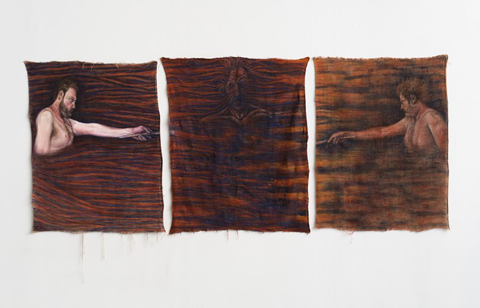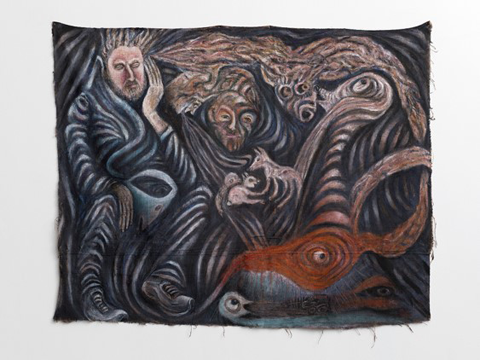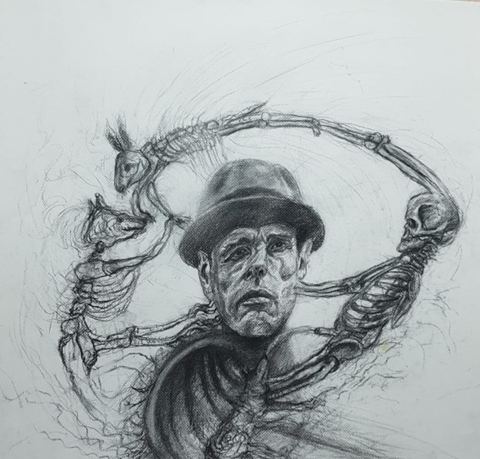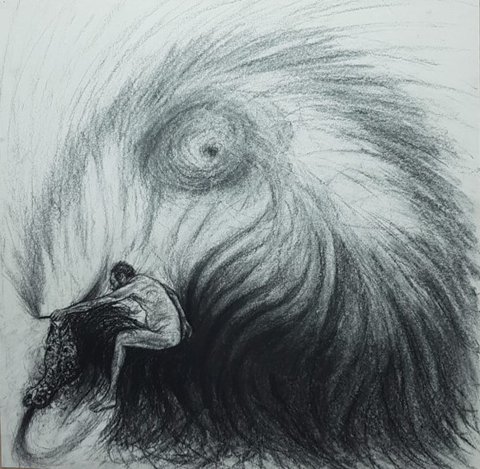-
CuratorshipAvi Ifergan
-
ArtistsAsaf Rahat
-
date22.07.23 - 01.10.23
The eye of Aviva Uri and the body of Joseph Beuys – Assaf Rahat.
The painting in three parts, “The Burner of the Fire” is the key to one of the questions that resonates implicitly or directly in the exhibition and that is what is the status of the artist in all the paths of society and culture. The artist sets the art on fire and at the end of the act of art is burned in his art. The painting “The Firestarter” alludes to the scene of the creation of man by Michelangelo Buonrotti on the ceiling of the Sistine Chapel in the Vatican in Rome. In Rahat’s painting, his naked body appears twice on both sides of the painting in the waves of fire, with his little hands outstretched and his hands holding brushes made of fiery flames that coat the surface of the painting with their waves and consume the artist who creates the work of art, and in the middle of the tapestry the artist’s figure, decaying, becomes a skeleton. In another painting in the exhibition, the artist walks, furniture with a brush in his hand and levels his way between the paths of fire of the art, emerging from the underworld, and when his brush touches the surface of the canvas, a burst of fire takes place. “Ghosts and the skeletons from the art book closet meet in my paintings”, this is how Rahat expressed himself regarding the meeting of the skeletons and the fathers of Israeli and international art in his paintings, meetings between the flesh and bones that are exposed under the skin that is not there, and transitions between the animal and the dead. And also the appearance of the artist’s portrait, partly covered with skin and flesh and partly with the bare skull bone, and the portrait sings a macabre look to the viewer, in this painting Rehat hints and sneers with sarcasm, that everything passes and even in what you are watching this moment is the end of possibilities. Rahat produces unexpected encounters in his painting field. He creates fictions and creates funny and smiling essays and does not skimp on hybrids. In one of the charcoal drawings on paper, he disrupts the scene of Joseph Beuys’s iconic performance “How to Explain a Painting to a Dead Rabbit”, by blowing a blaster of wind into the rabbit, which shoots Beuys. In his paintings, you meet the gaze of Aviva Uri, who is focused through her discerning eye with the sharpness of a razor, as the sharpness of her drawing. Boyce’s character and body in a series of scenes; Among them, the rabbit and the coyote are stripped of their skin and flesh and presented to us with graphic joy as skeletons. Streichman appears in Rahat’s dream when at the bottom of the painting a “bus in the mountains” by Arya Aroh is traveling. And Rafi Lavi, Moshe Gershoni, Aviva Uri and Yitzhak Danziger’s feminine Nimrod meet in the Purgatory, and in Rahat’s Shaul. The fathers of Israeli art are conjured up in a kind of painterly necrophilia séance with a brush juggling amusing combinations and full of love for art and their art. As Dante Algiers was escorted by Virgil through the paths of the inferno and purgatory, so did Marek furnish the sins of art to take him out of limbo.
Avi Ifergan
-
CuratorshipAvi Ifergan
-
date22.07.23 - 01.10.23
-
ArtistsAsaf Rahat







